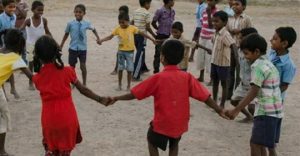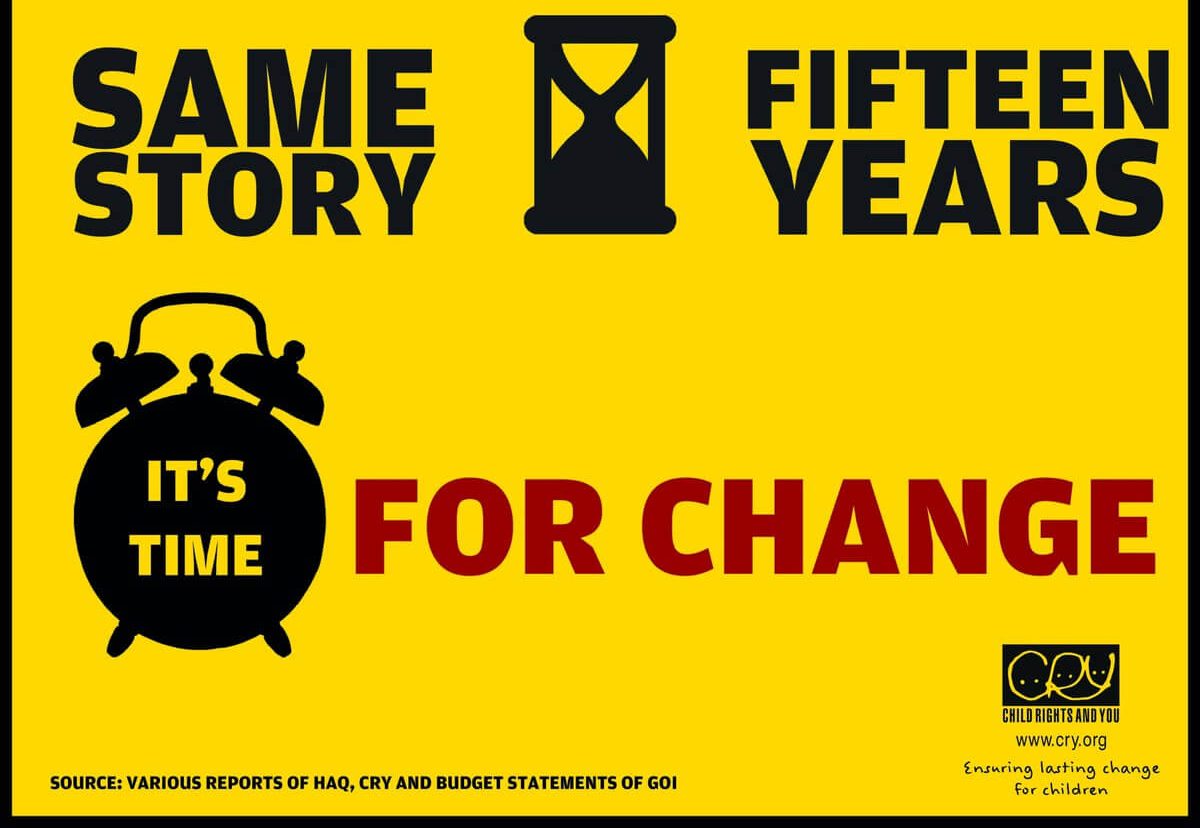Budget needs to step up funding for protection, health care and education to improve the country’s child development index, states CRY. A report for Different Truths.
With just a couple of days to go before it is tabled in the Parliament, the Annual Union Budget has caught up public attention. Being one of the concrete and visible indicators of the nation’s planning for the next fiscal year, the budget shows the intent of the Government, and highlights the priority it sets to achieve short and long term development goals, stated CRY media release.
After the implementation of the 14th Finance Commission recommendations (i.e. 2015-16 budget onwards), budget for children has remained almost stagnant at a little more than 3 per cent of the overall budget outlay
Over the past few years Union Budget did not do enough for children. After the implementation of the 14th Finance Commission recommendations (i.e. 2015-16 budget onwards), budget for children has remained almost stagnant at a little more than 3 per cent of the overall budget outlay, with only minor incremental increases at certain child-centric programmes, it was added.
 BE: Budget estimates
BE: Budget estimates
However, according to CRY – Child Rights and You, a leading non-profit organisation working for child rights in India, small incremental increases are not enough for bringing in sustainable change in the overall child development scenario in the country, and hence, should give way to exponential increase in budgetary allocations in education, health and protection of children.
Puja Marwaha, the CEO at CRY said, “In article 39 (F), the Indian Constitution has directed the State to implement policies towards ensuring overall development of children, and it is with this mandate that the Government of India has set forth targets on critical indicators for children
Puja Marwaha, the CEO at CRY said, “In article 39 (F), the Indian Constitution has directed the State to implement policies towards ensuring overall development of children, and it is with this mandate that the Government of India has set forth targets on critical indicators for children across thematic areas such as Education, Health, Nutrition, Development and Protection, as stated in the National Plan of Action for Children (2016). Further, with advent of the 2030 Sustainable Development Goals, India’s progress on key goals such as poverty and hunger, health care, education and access to water and sanitation are seen as crucial for its emerging future.
“We hope that the Union Budget 2020-21 will show a positive intent for the child, both in letter and spirit. Children need a safe, protecting and enabling environment in which they can learn, grow and develop to their full potential. Translated in terms of deliverables, it needs well designed interventions and adequate investment in these endeavours,” Puja stated.
“As the coming decade will possibly see the biggest cohort of India’s children slowly move into adulthood, therefore, giving them a strong present and a solid foundation for the future is the need of the hour, and the current budget needs to be aligned with the promises made by the nation in this regard,” she added.
Five Major Areas the Upcoming Budget Needs to Step Up Funding
- Investing in a robust secondary school education system:The education system of India continues to focus more on primary education with substantially higher number of primary schools as compared to upper primary and secondary levels of schooling. Hence, while India is showing improvement in the context of reaching primary education targets, progress is slow in access to secondary education and with respect to quality education parameters.
The implication of less number of schools available at higher standards is clearly visible if we consider the enrolment rates across levels of education and by population groups.
The implication of less number of schools available at higher standards is clearly visible if we consider the enrolment rates across levels of education and by population groups. Especially as children reach secondary education, school dropout rates show a sudden spike, from 4.13% at primary level to 17.06% at secondary level, with substantially greater percentage for the vulnerable groups (19.36% for Scheduled Caste and 24.68% for Scheduled Tribes groups) [Source: Educational Statistics at a Glance, 2018]. Completion of secondary education has a larger transformative role for children and the young generation in the rapidly changing technological and employment scenario in today’s times.
If India has to meet SDG Goal in ensuring that all children have access to equitable, free and quality primary and secondary education by 2030, it needs to invest considerably in its educational system.
The draft New Education Policy 2019 has stressed the restructuring of school curriculum with 3 years of pre- primary and the first two years of primary schooling making up the first foundational phase of learning.
- Building the pre-primary school education system:Pre-primary or early childhood education is where the foundation of learning is laid. The draft New Education Policy 2019 has stressed the restructuring of school curriculum with 3 years of pre-primary and the first two years of primary schooling making up the first foundational phase of learning. Since a majority of states currently have not made provisions for pre-school education, whether through Anganwadis or downward extension of school system, there’s a substantial quantum of work that is awaiting us. All these requirements indicate the need for adequate investment, both in terms of financial as well as human resources.
Emphasising ground action on reduction of child malnutrition:The past few years have seen some major transformations in terms of the nation’s progress vis-à-vis child nutrition and development. Yet, our health indicators for children look far from satisfactory.
This ambitious target can only be achieved through adequate administrative support and prioritisation, and overcoming delays in technological and infrastructural support through multi-stakeholder actions.
Poshan Abhiyan, launched in 2018, is to roll out to cover all districts across the country, with an overall target of reduction in stunting among young children from 38.4% (NFHS-4) to 25% by 2022. Yet, on-ground implementation continues to be patchy and the pace of progress across districts is slow (NITI Ayog, 2019). This ambitious target can only be achieved through adequate administrative support and prioritisation, and overcoming delays in technological and infrastructural support through multi-stakeholder actions.
- Ensuring comprehensive interventions for adolescent girls:Adolescent girls are subject to a several vulnerabilities, a number of which have the potential to derail their lives. Those who drop out of school are more likely to get married at any early age, and out of these, more than half (52%) of married adolescent girls become mothers at an early age [Source: NFHS-IV, 2015-16].
Ensuring health and nutrition status of girls before pregnancy, combating child marriage, continued schooling and life skill education and skilling opportunities can break this cycle of early motherhood and consequent inter-generational malnutrition.
Even though the RMNCH+A (Reproductive, Maternal, New- born, Child and  Adolescent Health) strategy has been taken in widening the scope of maternal and child health to include adolescents as part of the ‘continuum of care’, there is still dearth of well-designed interventions that support this vulnerable group. Ensuring health and nutrition status of girls before pregnancy, combating child marriage, continued schooling and life skill education and skilling opportunities can break this cycle of early motherhood and consequent inter- generational malnutrition.
Adolescent Health) strategy has been taken in widening the scope of maternal and child health to include adolescents as part of the ‘continuum of care’, there is still dearth of well-designed interventions that support this vulnerable group. Ensuring health and nutrition status of girls before pregnancy, combating child marriage, continued schooling and life skill education and skilling opportunities can break this cycle of early motherhood and consequent inter- generational malnutrition.
In this context Rashtriya Kishore Swasthya Karyakram (RKSK) is a welcome initiative that ensures comprehensive preventive and curative health care for the adolescents. However, there is a need to increase its outreach and evaluate and assess the outreach and outcome of the programme in details.
- A systemic approach in preventing child marriages:Census 2011 figures suggests that more than 17 million children (10 to 19 years age group) were married, illustrating not just the need for immediate intervention, but also the need to relook current approaches. India has a law on child marriage prohibition, intervention machinery supposed to identify and prevent such marriages from taking place and awareness and incentive programmes that attempt to mitigate cost of early marriage.
A systemic approach at improving gender parity in schooling, incentivizing skill based opportunities for girls and improving gender participation and safety in work and social support needs urgent exploration.
However, despite all of these, numbers of cases filed continue to be unbelievably less (NCRB 2017 report released recently revealed that only 395 cases had been reported under the Prohibition of Child Marriage Act, 2006). A systemic approach at improving gender parity in schooling, incentivizing skill based opportunities for girls and improving gender participation and safety in work and social support needs urgent exploration. India needs to make the shift from protecting girls from violations and harassment to a welcoming space for their participation in all walks of life.
Schemes such as ‘Beti Padhao Beti Bachao’ have assisted in developing an overall supportive environment regarding girl children. But the existing child protection system falls short of providing prevention services and adequate investment is needed to develop supportive mechanisms that would be helpful in addressing the issue in a meaningful way. The child protection budgets are still more service focussed though more investments are required on prevention, rehabilitation and restoration.
Photo from the internet





 By
By


 By
By